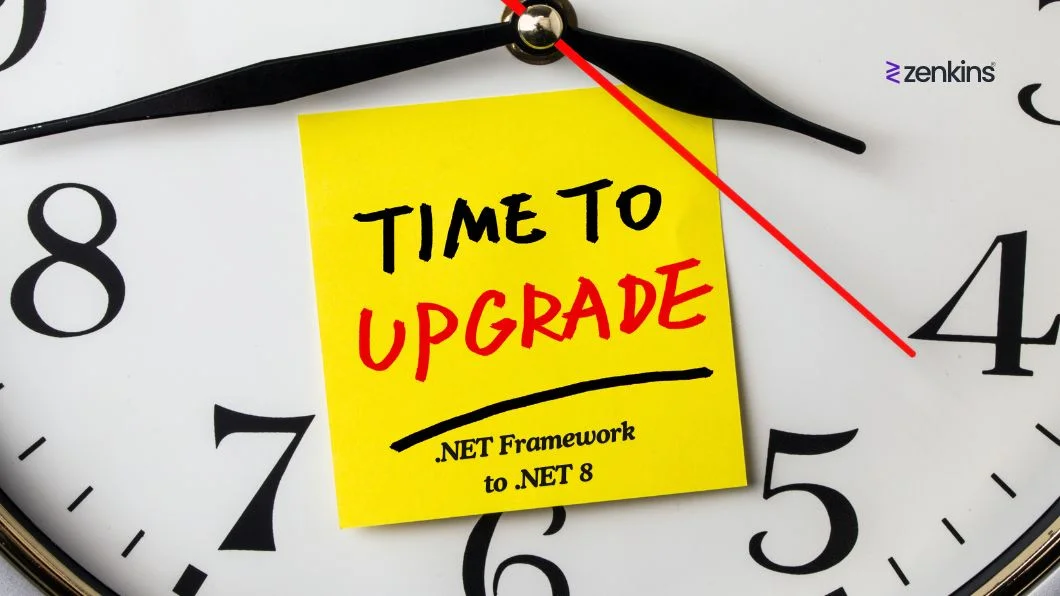Migrating from .NET Framework to .NET 8: A Step-by-Step Guide
Table of Contents
Introduction
Migrating from .NET Framework to .NET 8 is a critical step for many businesses seeking to modernize their applications and leverage the latest features, performance improvements, and security enhancements offered by .NET 8. This transition not only ensures that applications remain supported but also allows them to take full advantage of the cross-platform capabilities, improved performance, and new APIs that .NET 8 brings to the table.
In this comprehensive guide, we’ll walk you through the entire migration process from .NET Framework to .NET 8. We’ll cover everything from initial planning and preparation to executing the migration and optimizing your application for the .NET 8 environment. By the end of this guide, you’ll have a clear understanding of how to migrate your applications smoothly and efficiently.
Why Migrate from .NET Framework to .NET 8?
Migrating from .NET Framework to .NET 8 offers several compelling benefits:
- Cross-Platform Support: .NET 8 allows you to build and run applications on Windows, Linux, and macOS, expanding your deployment options and reaching a broader audience.
- Performance Enhancements: .NET 8 comes with significant performance improvements, making your applications faster and more efficient.
- Modern Development Tools: Access to the latest development tools, APIs, and language features that improve developer productivity and application quality.
- Long-Term Support (LTS): .NET 8 provides long-term support, ensuring that your applications remain secure and supported over the long term.
- Improved Security: .NET 8 includes the latest security features, helping protect your applications from vulnerabilities.
Step-by-Step Guide to Migrating from .NET Framework to .NET 8
Step 1: Assess Your Application
Before beginning the migration process, it’s crucial to conduct a thorough assessment of your existing application. This step involves:
- Identifying Dependencies: List all the external libraries, third-party packages, and dependencies used by your application. Check for compatibility with .NET 8.
- Analyzing Codebase: Review your application’s codebase to identify features, APIs, and patterns that are not supported in .NET 8.
- Understanding Application Architecture: Evaluate the architecture of your application to determine if it aligns well with the modular and modern design principles encouraged by .NET 8.
- Performance Benchmarks: Benchmark the current performance of your application to have a baseline for comparing post-migration performance.
Step 2: Plan the Migration
Proper planning is key to a successful migration. This phase involves:
- Defining Objectives: Clearly define the objectives of your migration. Is the goal to improve performance, enhance scalability, or take advantage of new features?
- Choosing the Right Migration Path: Decide whether to migrate the entire application at once (big bang approach) or incrementally (side-by-side approach).
- Create a Backup and Rollback Plan: Always have a backup of your current system and a plan to revert changes if anything goes wrong during the migration process.
- Resource Allocation: Allocate the necessary resources, including time, budget, and personnel, for the migration.
Step 3: Prepare the Development Environment
Set up your development environment to support .NET 8:
- Install .NET 8 SDK: Download and install the .NET 8 SDK from the official Microsoft website.
- Update Development Tools: Update your IDE (e.g., Visual Studio, Visual Studio Code) to the latest version that supports .NET 8.
- Configure Build Pipelines: Update your CI/CD pipelines to include .NET 8 in the build and deployment processes.
Step 4: Upgrade Project Files
Begin by upgrading your project files to the .NET 8 format:
- Convert Project Files: Use the
dotnet migratetool or manually update your project files from the old .NET Framework format (.csprojfiles) to the new .NET Core/8 format. - Update NuGet Packages: Replace incompatible packages with their .NET 8 compatible counterparts. If a direct replacement is not available, look for alternative libraries that provide similar functionality.
- Update Configurations: Adjust configuration files, such as
appsettings.json, to align with .NET 8 standards.
Step 5: Code Modifications
After upgrading the project files, you’ll need to modify your code to ensure compatibility with .NET 8:
- API Changes: Replace deprecated or removed APIs with their recommended alternatives in .NET 8.
- Dependency Injection: Refactor code to use dependency injection, which is a key aspect of the .NET Core/8 architecture.
- Asynchronous Programming: Take advantage of asynchronous programming models to improve performance, especially for I/O-bound operations.
- Modularization: Break down monolithic code structures into modular components or microservices, aligning with the modern architecture patterns supported by .NET 8.
Step 6: Testing and Validation
Testing is a critical step in the migration process:
- Unit Testing: Ensure all existing unit tests pass and create new tests for any new code paths introduced during migration.
- Integration Testing: Validate the interactions between different parts of your application and external systems.
- Performance Testing: Compare the performance metrics of the migrated application against the baseline to ensure that migration goals are met.
- User Acceptance Testing (UAT): Conduct UAT to ensure that the application meets the functional requirements from the end-user perspective.
Step 7: Deployment
Once testing is complete and the application is stable, you can proceed to deploy the migrated application:
- Choose the Right Deployment Strategy: Decide whether to deploy to the cloud, on-premises, or in a hybrid environment based on your business needs.
- Monitor Post-Deployment: Use monitoring tools to keep an eye on application performance and user feedback after deployment to quickly address any issues.
- Optimize and Tune: Post-deployment, continue to optimize the application for performance and scalability based on real-world usage data.
Common Challenges in Migrating from .NET Framework to .NET 8
- Compatibility Issues: Some legacy libraries and APIs may not have direct equivalents in .NET 8, requiring workarounds or custom implementations.
- Performance Tuning: While .NET 8 generally offers better performance, migrating without proper tuning can sometimes result in performance degradation.
- Learning Curve: Teams unfamiliar with .NET Core/8 concepts may face a learning curve, especially with dependency injection, configuration management, and cross-platform deployment.
- Testing Overheads: Comprehensive testing is crucial but can be time-consuming, especially if the application is large and complex.
- Resource Allocation: Underestimating the resources required for migration can lead to delays and unexpected costs.
Best Practices for a Successful Migration
- Start Small: Begin with less critical modules or services to gain experience and confidence before migrating the entire application.
- Automate Testing: Utilize automated testing tools to streamline the validation process and catch issues early.
- Leverage Community and Support: Make use of the .NET community resources, forums, and official Microsoft documentation for guidance and troubleshooting.
- Iterate and Improve: Migration is not a one-time task. Continuously iterate and improve your application post-migration to take full advantage of .NET 8 features.
- Keep Security in Mind: Regularly update dependencies and apply security best practices to protect your application in the new environment.
FAQs: Migrating from .NET Framework to .NET 8
What is the difference between .NET Framework and .NET 8?
.NET Framework is a Windows-only platform, while .NET 8 is a cross-platform framework that supports Windows, Linux, and macOS. .NET 8 includes modern features, improved performance, and long-term support that are not available in .NET Framework.
Can I migrate all my applications directly to .NET 8?
Not all applications can be migrated directly without modification. Applications heavily reliant on Windows-specific features or outdated libraries may require significant refactoring or replacement of components.
How long does it take to migrate from .NET Framework to .NET 8?
The migration timeline depends on the size and complexity of your application, the compatibility of your existing codebase, and the resources available. Simple applications may take a few weeks, while more complex ones could take several months.
What tools can help with the migration process?
Microsoft provides tools like the .NET Upgrade Assistant and the .NET Portability Analyzer to help identify and resolve compatibility issues during migration. Additionally, IDEs like Visual Studio offer built-in support for .NET 8.
Will my application perform better after migrating to .NET 8?
In most cases, yes. .NET 8 offers significant performance improvements over .NET Framework. However, achieving optimal performance may require refactoring and tuning specific to the .NET 8 environment.
Do I need to rewrite my entire application for .NET 8?
Not necessarily. Many applications can be migrated with minimal code changes, especially if they use standard libraries and patterns. However, some parts may need to be rewritten, especially if they depend on outdated or unsupported technologies.
How do I handle third-party dependencies during migration?
Check for .NET 8 compatible versions of your third-party dependencies. If none exist, look for alternatives or consider removing or rewriting the dependent functionality.
What are the costs associated with migrating to .NET 8?
Costs can include developer time, training, new tools, and potential downtime during the migration. However, these costs are often outweighed by the benefits of improved performance, security, and support.
Is it mandatory to migrate to .NET 8?
While it’s not mandatory, migrating to .NET 8 is recommended for applications that need ongoing support, performance improvements, and the ability to leverage new features. Older versions of .NET Framework will eventually lose support, which can pose security risks.
What support is available from Microsoft for migrating to .NET 8?
Microsoft offers extensive documentation, tools, and community support for migrating to .NET 8. They also provide professional services and consultancy for more complex migration projects.
Conclusion
Migrating from .NET Framework to .NET 8 is a strategic move that can yield significant benefits, including improved performance, enhanced security, and access to modern development features. While the process can be complex, following a structured approach and leveraging available tools and best practices can ensure a smooth transition. By investing in this migration, you position your applications and your business for future growth and innovation.
If you have any questions or need assistance with your migration journey, feel free to reach out to Zenkins. Our team of experts is ready to help you make the most of .NET 8 for your business needs.




